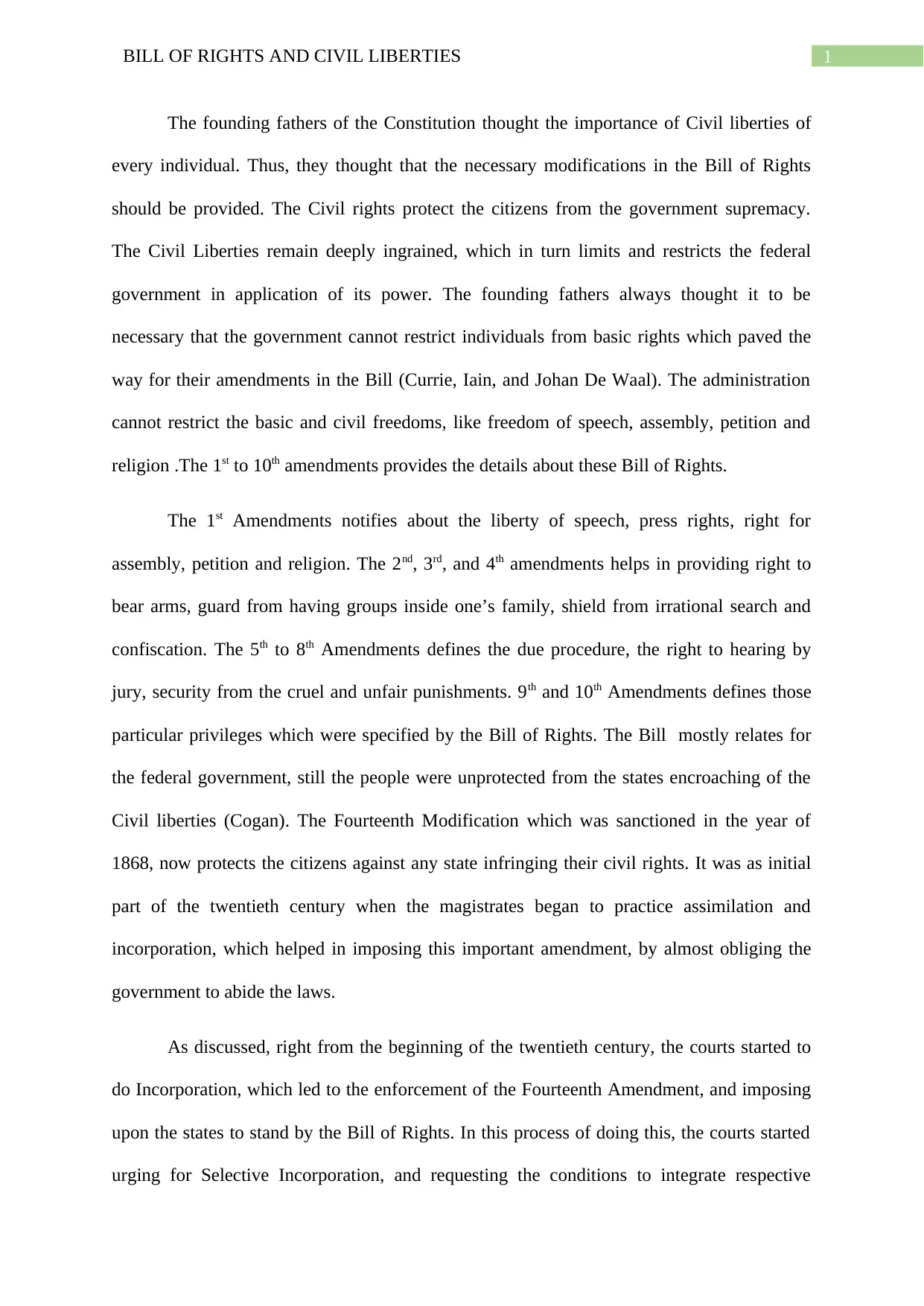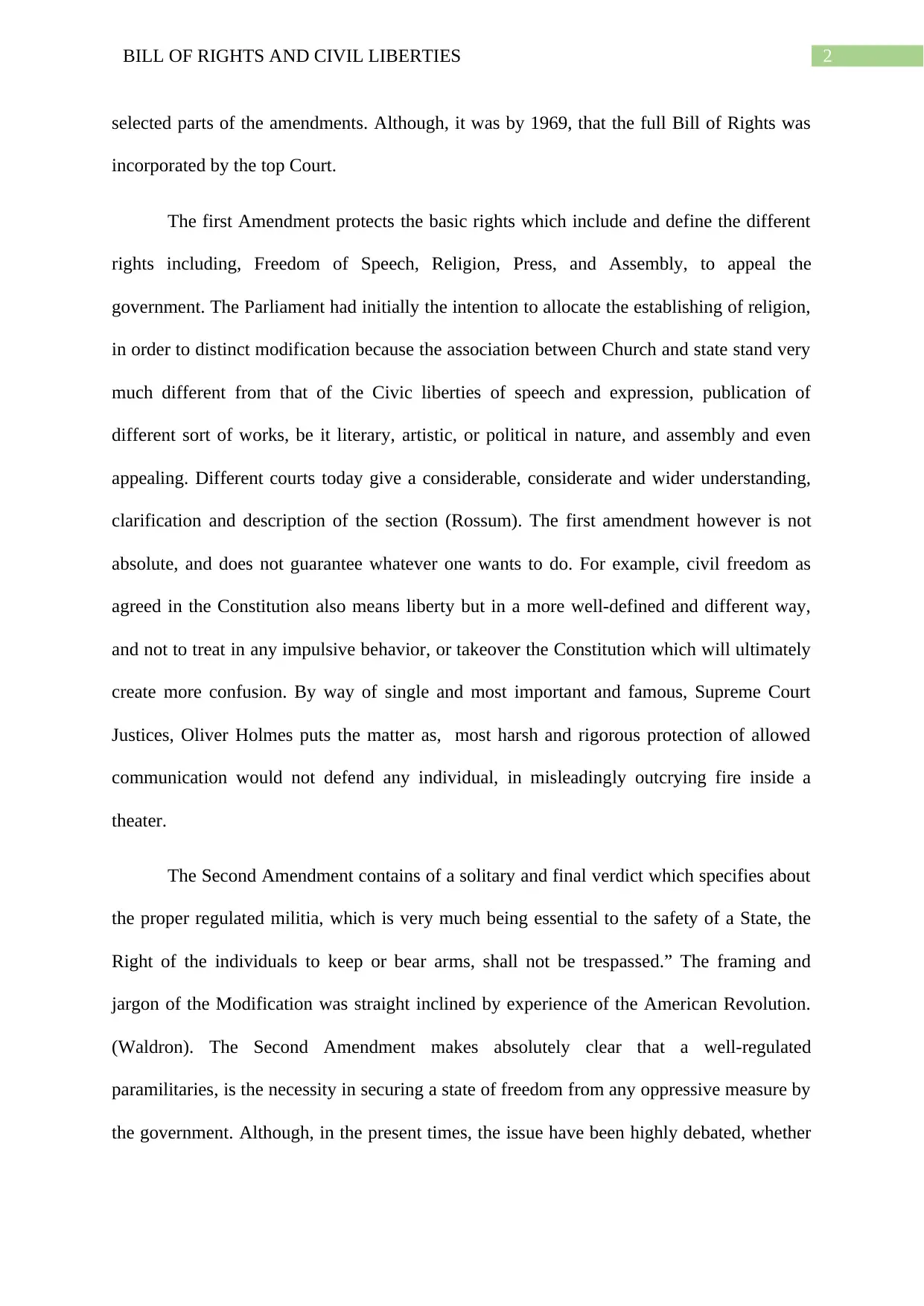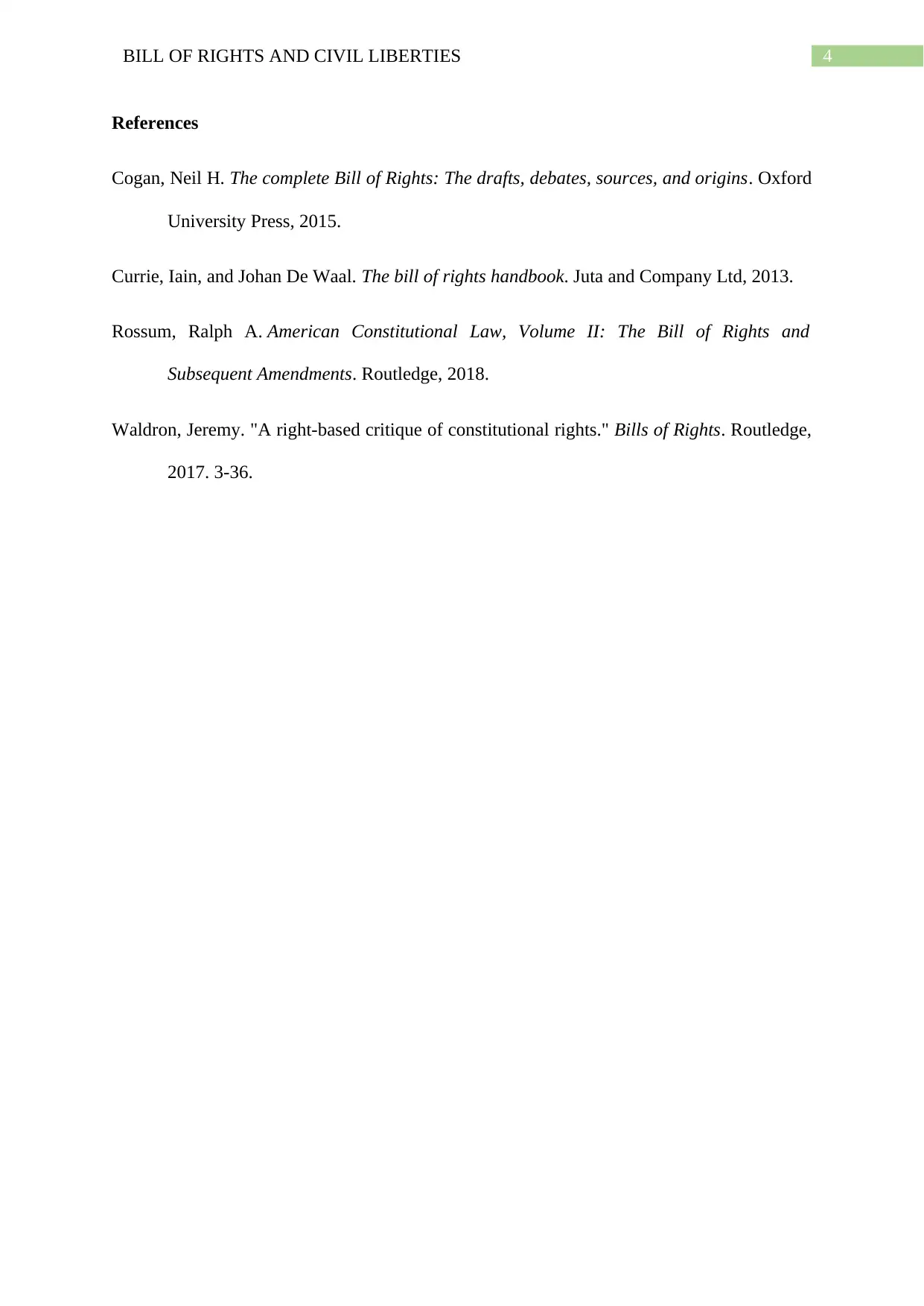Detailed Examination of the Bill of Rights and Civil Liberties
VerifiedAdded on 2022/11/13
|5
|915
|496
Essay
AI Summary
This essay provides an overview of the Bill of Rights and civil liberties, highlighting their importance in protecting individual freedoms from government overreach. It examines the First Amendment, covering freedom of speech, religion, press, assembly, and petition. The essay also explores the Second Amendment concerning the right to bear arms. Furthermore, it discusses the Fourteenth Amendment and the process of incorporation, which extended the Bill of Rights' protections to the states. The essay references key court cases and legal scholars, offering a comprehensive analysis of these fundamental rights and their evolution within the American legal system. The author emphasizes the ongoing debates surrounding these rights and their application in contemporary society, including the limits of free speech and the implications of the Second Amendment.

Running head: BILL OF RIGHTS AND CIVIL LIBERTIES
BILL OF RIGHTS AND CIVIL LIBERTIES
Name of the Student
Name of the University
Author Note
BILL OF RIGHTS AND CIVIL LIBERTIES
Name of the Student
Name of the University
Author Note
Paraphrase This Document
Need a fresh take? Get an instant paraphrase of this document with our AI Paraphraser

1BILL OF RIGHTS AND CIVIL LIBERTIES
The founding fathers of the Constitution thought the importance of Civil liberties of
every individual. Thus, they thought that the necessary modifications in the Bill of Rights
should be provided. The Civil rights protect the citizens from the government supremacy.
The Civil Liberties remain deeply ingrained, which in turn limits and restricts the federal
government in application of its power. The founding fathers always thought it to be
necessary that the government cannot restrict individuals from basic rights which paved the
way for their amendments in the Bill (Currie, Iain, and Johan De Waal). The administration
cannot restrict the basic and civil freedoms, like freedom of speech, assembly, petition and
religion .The 1st to 10th amendments provides the details about these Bill of Rights.
The 1st Amendments notifies about the liberty of speech, press rights, right for
assembly, petition and religion. The 2nd, 3rd, and 4th amendments helps in providing right to
bear arms, guard from having groups inside one’s family, shield from irrational search and
confiscation. The 5th to 8th Amendments defines the due procedure, the right to hearing by
jury, security from the cruel and unfair punishments. 9th and 10th Amendments defines those
particular privileges which were specified by the Bill of Rights. The Bill mostly relates for
the federal government, still the people were unprotected from the states encroaching of the
Civil liberties (Cogan). The Fourteenth Modification which was sanctioned in the year of
1868, now protects the citizens against any state infringing their civil rights. It was as initial
part of the twentieth century when the magistrates began to practice assimilation and
incorporation, which helped in imposing this important amendment, by almost obliging the
government to abide the laws.
As discussed, right from the beginning of the twentieth century, the courts started to
do Incorporation, which led to the enforcement of the Fourteenth Amendment, and imposing
upon the states to stand by the Bill of Rights. In this process of doing this, the courts started
urging for Selective Incorporation, and requesting the conditions to integrate respective
The founding fathers of the Constitution thought the importance of Civil liberties of
every individual. Thus, they thought that the necessary modifications in the Bill of Rights
should be provided. The Civil rights protect the citizens from the government supremacy.
The Civil Liberties remain deeply ingrained, which in turn limits and restricts the federal
government in application of its power. The founding fathers always thought it to be
necessary that the government cannot restrict individuals from basic rights which paved the
way for their amendments in the Bill (Currie, Iain, and Johan De Waal). The administration
cannot restrict the basic and civil freedoms, like freedom of speech, assembly, petition and
religion .The 1st to 10th amendments provides the details about these Bill of Rights.
The 1st Amendments notifies about the liberty of speech, press rights, right for
assembly, petition and religion. The 2nd, 3rd, and 4th amendments helps in providing right to
bear arms, guard from having groups inside one’s family, shield from irrational search and
confiscation. The 5th to 8th Amendments defines the due procedure, the right to hearing by
jury, security from the cruel and unfair punishments. 9th and 10th Amendments defines those
particular privileges which were specified by the Bill of Rights. The Bill mostly relates for
the federal government, still the people were unprotected from the states encroaching of the
Civil liberties (Cogan). The Fourteenth Modification which was sanctioned in the year of
1868, now protects the citizens against any state infringing their civil rights. It was as initial
part of the twentieth century when the magistrates began to practice assimilation and
incorporation, which helped in imposing this important amendment, by almost obliging the
government to abide the laws.
As discussed, right from the beginning of the twentieth century, the courts started to
do Incorporation, which led to the enforcement of the Fourteenth Amendment, and imposing
upon the states to stand by the Bill of Rights. In this process of doing this, the courts started
urging for Selective Incorporation, and requesting the conditions to integrate respective

2BILL OF RIGHTS AND CIVIL LIBERTIES
selected parts of the amendments. Although, it was by 1969, that the full Bill of Rights was
incorporated by the top Court.
The first Amendment protects the basic rights which include and define the different
rights including, Freedom of Speech, Religion, Press, and Assembly, to appeal the
government. The Parliament had initially the intention to allocate the establishing of religion,
in order to distinct modification because the association between Church and state stand very
much different from that of the Civic liberties of speech and expression, publication of
different sort of works, be it literary, artistic, or political in nature, and assembly and even
appealing. Different courts today give a considerable, considerate and wider understanding,
clarification and description of the section (Rossum). The first amendment however is not
absolute, and does not guarantee whatever one wants to do. For example, civil freedom as
agreed in the Constitution also means liberty but in a more well-defined and different way,
and not to treat in any impulsive behavior, or takeover the Constitution which will ultimately
create more confusion. By way of single and most important and famous, Supreme Court
Justices, Oliver Holmes puts the matter as, most harsh and rigorous protection of allowed
communication would not defend any individual, in misleadingly outcrying fire inside a
theater.
The Second Amendment contains of a solitary and final verdict which specifies about
the proper regulated militia, which is very much being essential to the safety of a State, the
Right of the individuals to keep or bear arms, shall not be trespassed.” The framing and
jargon of the Modification was straight inclined by experience of the American Revolution.
(Waldron). The Second Amendment makes absolutely clear that a well-regulated
paramilitaries, is the necessity in securing a state of freedom from any oppressive measure by
the government. Although, in the present times, the issue have been highly debated, whether
selected parts of the amendments. Although, it was by 1969, that the full Bill of Rights was
incorporated by the top Court.
The first Amendment protects the basic rights which include and define the different
rights including, Freedom of Speech, Religion, Press, and Assembly, to appeal the
government. The Parliament had initially the intention to allocate the establishing of religion,
in order to distinct modification because the association between Church and state stand very
much different from that of the Civic liberties of speech and expression, publication of
different sort of works, be it literary, artistic, or political in nature, and assembly and even
appealing. Different courts today give a considerable, considerate and wider understanding,
clarification and description of the section (Rossum). The first amendment however is not
absolute, and does not guarantee whatever one wants to do. For example, civil freedom as
agreed in the Constitution also means liberty but in a more well-defined and different way,
and not to treat in any impulsive behavior, or takeover the Constitution which will ultimately
create more confusion. By way of single and most important and famous, Supreme Court
Justices, Oliver Holmes puts the matter as, most harsh and rigorous protection of allowed
communication would not defend any individual, in misleadingly outcrying fire inside a
theater.
The Second Amendment contains of a solitary and final verdict which specifies about
the proper regulated militia, which is very much being essential to the safety of a State, the
Right of the individuals to keep or bear arms, shall not be trespassed.” The framing and
jargon of the Modification was straight inclined by experience of the American Revolution.
(Waldron). The Second Amendment makes absolutely clear that a well-regulated
paramilitaries, is the necessity in securing a state of freedom from any oppressive measure by
the government. Although, in the present times, the issue have been highly debated, whether
⊘ This is a preview!⊘
Do you want full access?
Subscribe today to unlock all pages.

Trusted by 1+ million students worldwide

3BILL OF RIGHTS AND CIVIL LIBERTIES
this is the case when a blanket guarantee covers the arms laws, and some circumstances may
arise, in which some people will be allowed, to own or handle the firearms or not.
this is the case when a blanket guarantee covers the arms laws, and some circumstances may
arise, in which some people will be allowed, to own or handle the firearms or not.
Paraphrase This Document
Need a fresh take? Get an instant paraphrase of this document with our AI Paraphraser

4BILL OF RIGHTS AND CIVIL LIBERTIES
References
Cogan, Neil H. The complete Bill of Rights: The drafts, debates, sources, and origins. Oxford
University Press, 2015.
Currie, Iain, and Johan De Waal. The bill of rights handbook. Juta and Company Ltd, 2013.
Rossum, Ralph A. American Constitutional Law, Volume II: The Bill of Rights and
Subsequent Amendments. Routledge, 2018.
Waldron, Jeremy. "A right-based critique of constitutional rights." Bills of Rights. Routledge,
2017. 3-36.
References
Cogan, Neil H. The complete Bill of Rights: The drafts, debates, sources, and origins. Oxford
University Press, 2015.
Currie, Iain, and Johan De Waal. The bill of rights handbook. Juta and Company Ltd, 2013.
Rossum, Ralph A. American Constitutional Law, Volume II: The Bill of Rights and
Subsequent Amendments. Routledge, 2018.
Waldron, Jeremy. "A right-based critique of constitutional rights." Bills of Rights. Routledge,
2017. 3-36.
1 out of 5
Related Documents
Your All-in-One AI-Powered Toolkit for Academic Success.
+13062052269
info@desklib.com
Available 24*7 on WhatsApp / Email
![[object Object]](/_next/static/media/star-bottom.7253800d.svg)
Unlock your academic potential
Copyright © 2020–2025 A2Z Services. All Rights Reserved. Developed and managed by ZUCOL.




